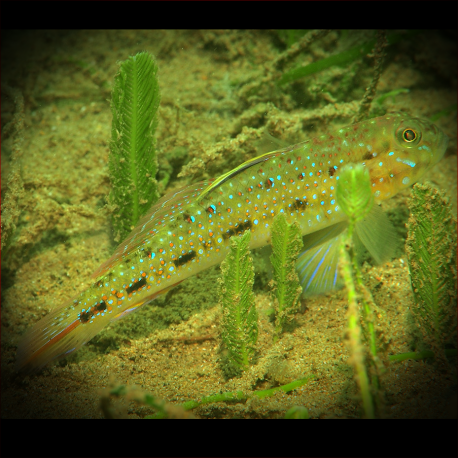More info
Datasheet
| Minimum Tank Size | 100 litres / 26.42 US gallons |
| Maximum Size | 11.0cm / 4.33inches |
| Reef Compatible | Always reef safe |
| Temperament | Might be aggressive towards similar species |
| Temperature | 22.2°C / 71.96°F - 25.6°C / 78.08°F |
| Specific Gravity | 1.020-1.025 |
| Carbonate Hardness | 8-12 |
| pH | 8.1-8.4 |
General Description
The Rigilius Goby, scientifically known as Istigobius rigilius, is a member of the Gobiidae family, characterized by its small size and bottom-dwelling nature. It is commonly referred to as the Orangespotted sandgoby or Brown-speckled sand-goby and is native to the Western Pacific region, spanning from the Philippines and Indonesia to Kiribati and Fiji.
Aquarium Suitability
Considered suitable for aquariums, the Rigilius Goby requires diligent care due to its specific demands and temperament. They can be aggressive towards similar species and are known to jump out of open aquaria, hence caution is advised when housing them.
Demands, Care, and Hardiness
With an average hardiness level, these gobies thrive best in environments with hiding spots like live rocks, and they may cover corals with sand while feeding. They filter sand in search of food and require frequent feeding, particularly when introduced to a new aquarium. They also suggest thriving better without other members of their species present.
Reef Suitability
The Rigilius Goby is classified as always reef safe, making them a suitable addition to reef aquariums without posing a threat to coral or other reef inhabitants.
Aquarium Setup
To cater to the needs of the Rigilius Goby, a tank size of at least 100 liters is recommended, with a stable temperature range of 22.2-25.6°C, pH between 8.1-8.4, and specific gravity from 1.020-1.025. They prefer water with a carbonate hardness of 8-12 dKH.
Behaviour
This species exhibits distinct behavior patterns, often seeking shelter in hiding spots like live rocks and displaying territorial behavior, especially towards similar species within the tank.
Feeding and Diet
Their diet primarily consists of small crustaceans like krill, mysis, and artemia, in addition to zooplankton such as Cyclops and pods. Regular feeding several times a day is crucial for their well-being, ensuring they receive adequate nutrition.
Dimorphism and Captive Reproduction
Although dimorphism details are not provided, captive reproduction of the Rigilius Goby in aquarium settings may be feasible with proper conditions and care.
Habitat and Distribution
In their natural habitat, these gobies are found in the waters of the Western Pacific, ranging from the Great Barrier Reef to locations like the Philippines and Indonesia, where they inhabit sandy substrates and rocky crevices.

